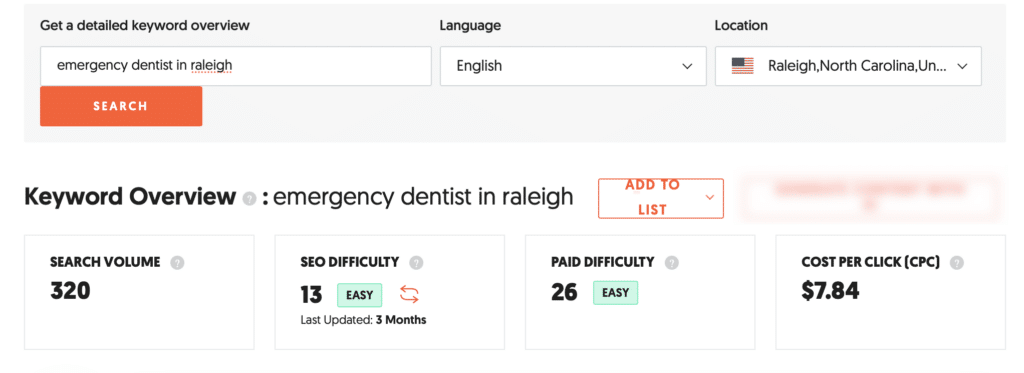Local SEO for Dentists: How Dental SEO Helps Get New Patients
The dental industry is as competitive as ever, with several practices vying for the attention of prospective patients within a town. It’s why relying on traditional marketing techniques and word of mouth is simply not enough anymore, especially if you hope to stand out. Add to this how overwhelming being inundated with search results can […]

The dental industry is as competitive as ever, with several practices vying for the attention of prospective patients within a town. It’s why relying on traditional marketing techniques and word of mouth is simply not enough anymore, especially if you hope to stand out. Add to this how overwhelming being inundated with search results can be for a patient searching for a dentist or specific service.
However, dentists have the power to make searching for the right dentist easier and a whole lot less stressful for potential patients. How? The answer is straightforward: dental SEO. Join us as we unpack the many facets of local SEO for dentists and explore how it can transform your dental practice.
What is Dental SEO?
Dental SEO, at its core, refers to the strategies and techniques employed to improve the online visibility of dental practices. It involves optimizing your website, producing high-quality content, and ensuring that when someone types in keywords related to dental services in your area, your practice appears at the top of search results. Given that a significant chunk of consumers turn to online searches to find local services, mastering dental SEO can be the game-changer your practice needs.
The Importance of Local SEO for Dentists
Local SEO focuses on promoting businesses within a specific geographical area. For dentists, this means targeting potential patients within the vicinity of their practice. Here’s why it’s crucial:
- Proximity Matters: Most patients prefer a dentist close to their residence or workplace because it’s not something people are willing to travel for unless you’re a specialist. Local SEO ensures you are visible to those in your immediate vicinity.
- Increased Web Traffic: When your practice ranks high for local searches, you’ll see a significant boost in organic web traffic.
- Higher Conversion Rates: People searching for dental services nearby are more likely to convert, as they’re actively seeking the services you offer.
Strategies To Boost Your Dental SEO
There are a couple of tried and tested local SEO strategies we stand by here at Pain-Free Dental Marketing, and we’re giving you a glimpse into what they are.
1. Optimize Your Website:
Our first port of call when we start working with a new dental practice is always the website. With the majority of patients conducting searches on their mobile phones, it is non-negotiable that every dental website is responsive and looks good across all screen sizes. If your website is not mobile-friendly, not only will trying to find information be difficult for a prospective patient, but Google and other search engines will not make showing your website in search results a priority.
Next is load time. You know how frustrating it can be when a website takes forever to load, especially when you’re on a mission and looking for specific information. A slow website can deter patients from continuing to spend time on your website and drive them straight into the arms of your competitors. We use Google PageSpeed Insights and other audit tools to assess and improve site performance.
Another greatly overlooked aspect of optimizing your website for searches is having a clear call to action on every page. It should be easy for patients to book appointments. By making phone numbers prominent, adding online booking widgets, and having contact forms at the ready, your conversions will get a significant boost.
Last but not least, search engines favor content that is fresh and up to date. Those blog posts from 8 years ago won’t rank as well if you don’t continually update and refresh the content on your site.
2. Find Your High-Performing Keywords
The mistake many practices make is spending time creating content that isn’t going to convert because they’re going in blind. Instead of wasting your efforts on something that’s not going to bring more patients to your practice, you can hone in on the keywords that people are actually using to search.
Want even better results? Take it one step further than simply looking at the search queries people are using to find you and take a look at the volume of searches these queries get every month. If they’re too low, they’re also not worth investing significant resources into. You can use Google Search Console, Google Analytics and Google Trends for basic keyword data. If you’re looking for more in-depth insights, you can opt to use subscription tools like SEMrush, Ahrefs or Ubersuggest.

This brings us to the next point. A common keyword like “dentist” is going to have a huge search volume in your area… but it’s also going to have a lot of competition, making it really tough to rank for. This is where you can harness the magic of long-tail keywords which essentially take your core keyword and add them into a search query. So instead of simply trying to rank for “dentist,” you rather aim for “emergency dentist in [your city].
On that note, localize your keywords! Don’t make the mistake of targeting the whole county when you’re overlooking the patients in your city and neighboring communities. This is a goldmine for attracting local traffic!
3. Create High-Quality Content
Search engines like Google have made it clear they prioritize high-quality content that adds value. So, having one paragraph about your dental service isn’t going to cut it anymore. The goal should be to build out service pages that feature keyword-rich and well-written content, generally at least over 800 words long. Before you even think about adding blog posts, it’s essential every service page on your website has been properly optimized and localized.

Once that’s done, you can introduce regular blog posts that target your long-tail keywords. You can write about common dental problems, treatments, and preventive care. This can position you as an authority and answer potential patients’ queries.
Lastly, it’s really important to include images and videos on your website! Many people use images to search for information nowadays, so having these on your website only boosts your chances of a patient coming across your site while searching for a dentist near them.
4. Claim Your Google Business Page and Bing Places Listings
Google Business Page (formerly Google My Business) and Bing Places are essential for effective local SEO. If your listings exist, claim them and ensure all the information is filled out and correct. If you can’t find unclaimed listings, create new ones.
The most important information to check and optimize on your listings are:
- Your business name
- Your categories
- Your phone number
- Your address
- Your working hours
- Your description
Many people don’t realize this, but you should include those high-value keywords you discovered in step 2 into your listing description! Don’t keyword stuff – EVER! Use one or two keywords in a natural way that flows when you read it.
You’ll also want to make sure you’ve got some high-quality, professionally-taken photographs to add to your listing. These should include some headshots, pictures of your team, patient before and afters, as well as of your practice’s interior and exterior.
It’s also recommended you add regular posts to your listing. These can be in the form of updates, practice news, or special offers. Again, include your keywords in the content in a natural way.
5. Encourage Reviews
Don’t be afraid to ask for reviews! In our modern digital age, they are your practice’s unofficial spokesperson. Patients will often head straight to your reviews to see what kind of experience they’re in for, so we can’t emphasize enough how important reviews are in terms of actually converting that organic traffic into patients.
Google tends to show the listings of practices with more reviews higher in search results because it considers them to be trustworthy. So, how do you get more reviews? Here are some simple strategies:
- Have a QR code that directs them to your Google Business Page on their invoice
- Text or email a QR code or link for a review after their appointment
- Use a tool like Swell to supercharge your review-gathering efforts
- Respond to all reviews, both positive and negative
Metrics to Track Dental SEO Success
With paid ads, it’s easy to see your ROI, but SEO is a little more subtle. Here are some performance metrics to track to gauge whether your SEO efforts are paying off:
- Organic Traffic: Use tools like Google Analytics and Google Search Console to measure the number of visitors coming from search engines.
- Conversion Rate: Monitor how many website visitors turn into actual appointments by adding a form field for new patients, asking them how they heard about your practice.
- Keyword Rankings: Use Google Search Console or paid SEO tools to see how well your targeted keywords perform over time.
- Click-Through Rate (CTR): A high CTR suggests that your meta descriptions and titles are compelling to searchers and encourage them to click through to your website.
We Offer Local SEO for Dentists!
Dental SEO is a multifaceted approach that, when executed correctly, can bring remarkable results for your dental practice. By diving deep into optimization, focusing on local visibility, and diligently tracking metrics, you can ensure you’re making the most of your online presence. It’s an investment of time and effort that can lead to a sustained influx of new patients.
If you need help with Dental SEO, Pain-Free Dental Marketing is here for you! Our industry-leading SEO strategies have proven results again and again, and we can do the same for you!